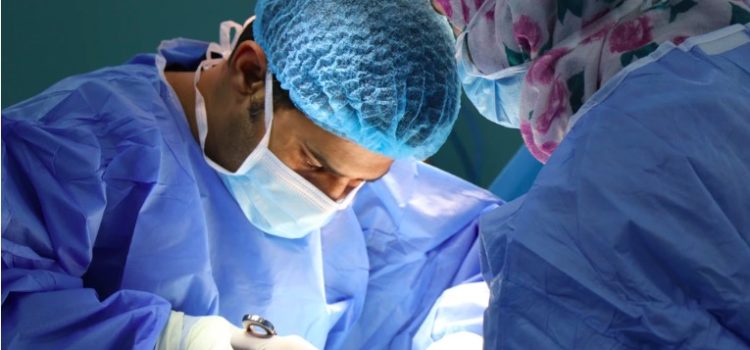

This article is an excerpt from the Shortform summary of "The Checklist Manifesto" by Atul Gawande. Shortform has the world's best summaries of books you should be reading.
Like this article? Sign up for a free trial here .
In 2006, before the implementation of the WHO surgical safety checklist, the World Health Organization (WHO) asked surgeon Atul Gawande to organize a group to solve a problem: Surgery was increasing rapidly worldwide, but surgical patients were getting unsafe care so often that surgery was a public danger. WHO sought a global program that would reduce avoidable harm and deaths from surgery.
We’ll cover how the WHO surgical safety checklist was developed, how it’s been implemented in hospitals across the country, and what results hospitals have seen from using the WHO surgical checklist.
The WHO Surgical Checklist Project
How did the WHO surgical safety checklist come to be?
Data from 193 countries showed that the volume of surgery worldwide had skyrocketed by 2004. Surgeries exceeded totals for childbirth, but the death rate for surgery was ten to one hundred times higher than for childbirth. At least seven million people a year were disabled by surgery, and one million died.
The growth was due in part to improved economic conditions, which increased people’s longevity and therefore their need for surgeries. Health systems were greatly increasing the number of surgical procedures performed and the types of surgeries. There were more than 2,500 different surgical procedures. Safety and quality of care for surgical patients was becoming a big issue everywhere.
Surgery is often life-saving, even when performed under dire or substandard conditions. But failures leave millions disabled or dead. In the U.S. alone, when Gawande began the WHO project, at least half of surgical complications were preventable, and there were a variety of causes and contributing factors. He set out to find examples of public health interventions and campaigns that had succeeded. He found several examples, all of which shared three characteristics: they were simple, their effects were measurable, and the benefits could be applied elsewhere. This was the origin of the WHO surgical safety checklist.
Simple, Measurable, and Applicable Solutions
A precursor to the WHO safe surgery checklist appeared in Pakistan.
WHO Surgical Safety Checklist Precursor #1: Pakistan
A U.S. public health worker in Pakistan came up with a way to reduce deaths, infections, and diseases among children in poor areas of Pakistan, with a high level of illiteracy, overcrowding, open sewers, and contaminated water.
The health worker provided soap donated by Proctor & Gamble along with simple guidelines describing six situations in which people should use it and instructions on hand-washing techniques. The soap was a behavior-change vehicle. People appreciated getting the free soap, even though some already had their own own soap. They also liked its scent and a significant number followed the instructions, which were basically a checklist. The incidence of diarrhea among children fell 52 percent. The incidence of pneumonia fell 48 percent and bacterial skin infections fell 35 percent.
The successful soap project was simple, measurable, and widely applicable.
WHO Surgical Safety Checklist Precursor #2: Columbus Children’s Hospital
In 2005, Columbus Children’s Hospital developed a checklist to reduce surgical infections, one of the most common complications of surgery in children. A key to avoiding infections is giving an antibiotic within sixty minutes before the surgeon makes an incision. However, this step was often missed — the hospital’s records showed that a third of pediatric appendectomy patients didn’t get the antibiotic at the right time.
So the hospital’s director of surgical administration designed a checklist, which was put on a whiteboard in each operating room. It included a step to confirm that antibiotics had been given. The director, who was also an airplane pilot, called the program “Cleared for Takeoff.” A key feature was a metal “tent” labeled with the slogan, which the nurse placed over the scalpel when she laid out the surgical instruments. The surgeon couldn’t start until the nurse gave the OK and removed the tent.
After three months of using the system, the surgical director found that 89 percent of appendicitis patients had received the antibiotic. After ten months, 100 percent did — the checks instilled a performance standard.
WHO Surgical Safety Checklist Precursor #3: University of Toronto
Another precursor to the WHO surgical safety checklist was used in Toronto.
The University of Toronto performed a feasibilty study using a 21-item surgical checklist designed to catch a range of potential errors in surgical care. It combined task checks with communication points.
The surgical staff had to verbally confirm each item on the list — for instance, that an antibiotic had been given, that the right type of blood was available, and that test results were on hand. The checklist also incorporated a team briefing to talk about any risks or concerns as well as expectations (for example, how much blood loss was expected and what things to be prepared for).
Researchers monitored use of the checklist in eighteen operations. In ten, it revealed significant problems or ambiguities, including individual patient problems that a checklist wouldn’t typically catch.
WHO Surgical Safety Checklist Precursor #4: Kaiser Hospitals
A fourth WHO surgical safety checklist precursor was tested in California.
A study at a group of Kaiser hospitals in southern California further underscored the importance of communication and a sense of teamwork in surgery. The hospitals tested a thirty-item “surgery preflight checklist.”
The checklist included preventive steps for surgery’s three biggest killers — infection, bleeding, and unsafe anesthesia. However, a fourth killer — the unexpected — can’t be dealt with as readily with check boxes. So the program addressed it by setting up communication checkpoints. The checklist required surgical staff to stop and talk through the case together in order to be ready as a team to identify and address each patient’s unique concerns and risks.
This was unusual because, typically, surgery is treated as a one-person show. The operating room is referred to as a theater and functions as the surgeon’s stage. Surgeons like to think that surgical staff perform as a team, but often they really don’t. For instance, not all team members are aware of a given patient’s risks, problems they need to be ready for, or even why the surgeon is doing the operation. One survey of 300 staff members leaving the OR showed that one in eight weren’t sure where the incision would be until the operation started. This one-person-show approach makes it more difficult for staff to come together effectively in a crisis.
Checklists requiring communication also address another problem with surgery — “silent disengagement.” This is the tendency of each person to focus on a specialized task, sticking to their own area of expertise while not questioning what anyone else is doing or paying attention to the big picture. To avoid failures in surgery, staff members need to see their job not just as performing specialized tasks, but also as helping the group get the best possible results. This requires working as a team to address problems that arise and to ensure nothing falls through the cracks.
Kaiser’s checklist insisted that people talk together, which fostered teamwork. It also required staff members to introduce themselves with their name and role, ensuring all team members knew each other’s names. Studies in various fields have shown that people who don’t know each other’s names don’t work as well together as those who do.
Further, research at Johns Hopkins showed that when nurses were given a chance at the beginning of a procedure to state their names and concerns, they were more likely to note problems during surgery and offer solutions. The researchers referred to this as the “activation phenomenon” because giving people a chance to speak early on activated a sense of responsibility and willingness to speak up.
Results of Checklists
Kaiser hospitals tested the checklist for six months in 3,500 operations. It caught numerous near errors, including almost doing the wrong procedure in one case. In addition, the rating by surgical staff of the teamwork climate improved from good to outstanding. Employee satisfaction rose and OR nurse turnover dropped.
None of these studies were proof that a checklist could be devised that would be effective and versatile enough to improve surgery outcomes around the world, but they provided a starting point for further exploration. Gawande and his team began drafting a potential surgical checklist, but soon realized they needed more information on what makes an effective checklist.
WHO Tests a Checklist
With information from Boorman on how to create an effective checklist, Gawande and his team created and began testing the WHO Surgical Safety Checklist.
They chose a Do-Confirm approach to give people greater flexibility in performing their tasks, but had them stop at key points to confirm they hadn’t missed any steps. When researchers tested the WHO Surgical Safety Checklist in a simulated surgery, they realized they hadn’t designated who was supposed to pause things and launch the checklist. They decided to have the circulating nurse call the pause rather than the surgeon, to send the message that everyone is responsible for the overall well-being of the patient in surgery.
They had a team in London try the WHO Surgical Safety Checklist, then one in Hong Kong, and continued to improve it. The final WHO checklist listed 19 checks with three pause points and it took two minutes to go through. The checks were divided as follows:
- Before anesthesia: seven steps, such as checking patient consent, medication allergies, and availability of replacement blood.
- After anesthesia and before making the incision: seven more checks, including making sure team members have been introduced by name and role and have discussed aspects of the operation.
- Before the patient leaves the OR: five checks, including an accounting of all surgical equipment and a review of plans for the patient’s recovery.
Next was a pilot study of the WHO Safe Surgery Checklist in eight hospitals around the world.
The researchers chose a diversity of hospitals, rich and poor, because failures can happen anywhere.
To establish a baseline, they collected data on current complications and death rates at the test sites. Of 4,000 patients, 400 had developed major complications from surgery and 56 died.
About half the complications involved infection, and a quarter involved failures that required a return to the OR to fix something or stop bleeding. Complication rates ranged from 6 to 21 percent, which indicated room for improvement everywhere.
They began implementing the WHO Surgical Safety Checklist in the pilot hospitals in spring 2008. To help get buy-in, they provided each hospital with its failure data to show what the list was trying to address. They presented the checklist as a tool for people to try in hopes of improving their results.
Use of the checklist was well underway within a month and they began hearing encouraging stories. For instance:
- In London, the before-incision part of checklist caught a wrong-size prosthetic knee about to be used as a replacement.
- In India, surgical staff discovered a flaw in their system: they were giving the antibiotic too soon. Frequent delays in the operating schedule meant it had worn off by the time surgery started, so they changed their system.
- In Seattle, they caught problems with antibiotics, equipment, and overlooked medical issues. They also found that going through the list helped the staff respond better if an unexpected problem came up — they worked better as a team.
Three-Month Results of the WHO Surgical Checklist
The results after just three months exceeded researchers’ hopes and expectations:
- Rates of major complications for surgical patients in all eight hospitals fell by 36 percent. Deaths fell 47 percent.
- Infections fell by almost half.
- The number of patients having to return to the OR because of problems fell by a quarter.
Overall, in the group of nearly 4,000 patients, 435 would have been expected to develop serious complications based on the baseline observation data. Instead just 277 did. Using the checklist had spared more than 150 people from harm and 27 of them from death.
Every hospital in the study saw a substantial reduction in complications. Seven of the eight hospitals experienced a double-digit drop. Because of their significance, the results were published by the New England Journal of Medicine in January 2009 as a rapid-release article.
Results had already begun to leak out prior to publication, and hospitals in Washington state had begun using Seattle’s checklist. The hospitals formed a coalition with Boeing (a major employer), the state’s insurers, and the governor to introduce the WHO Surgical Safety Checklist across the state and track data.
In Great Britain, the chairman of surgery at St. Mary’s Hospital, which was part of the study, became the country’s minister of health and helped launch a campaign to implement the checklist nationwide.
Some surgeons objected that the study had not clearly established how the WHO Surgical Safety Checklist was producing the results (the decline in complications from surgery). For instance, while the hospitals made improvements in procedures such as giving antibiotics and making sure they were doing the right procedure, the improvements didn’t explain why unrelated complications, like bleeding, fell.
Researchers suggested the results were due to improved communication. In spot surveys, surgical staff reported a significant increase in the level of communication. There also was a correlation between teamwork scores and results for patients — the more that teamwork improved, the more patient complications declined.
After using the WHO Surgical Safety Checklist for three months, more than 250 staff members filled out an anonymous survey. Among the results:
- 80 percent said the checklist was easy to use, didn’t take long, and improved care.
- 78 percent said they saw the checklist prevent an error.
- 93 percent agreed that if they were having an operation, they’d want the checklist to be used.
By increasing communication and setting standards, the WHO Surgical Safety Checklist has been successful in many different medical environments.
———End of Preview———

Like what you just read? Read the rest of the world's best summary of "The Checklist Manifesto" at Shortform . Learn the book's critical concepts in 20 minutes or less .
Here's what you'll find in our full The Checklist Manifesto summary :
- How checklists save millions of lives in healthcare and flights
- The two types of checklists that matter
- How to create your own revolutionary checklist






